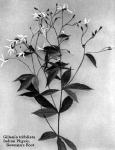 SYNONYM—Porteranthus trifoliatus
SYNONYM—Porteranthus trifoliatus
OTHER COMMON NAMES—Gilenia, bowman's-root, false ipecac, western dropwort, Indian-hippo.
HABITAT AND RANGE—Indian-Physic is native in rich woods from New York to Michigan, south to Georgia and Missouri.
DESCRIPTION OF PLANT—The reddish stems of this slender, graceful perennial of the rose family (Rosaceae) are about 2 to 3 feet high, several erect and branched stems being produced from the same root. The leaves are almost stemless and trifoliate; that is, composed of three leaflets. They are ovate or lanceolate, 2 to 3 inches long, narrowed at the base, smooth and toothed. The nodding, white pinkish flowers are few, produced in loose terminal clusters from May to July. The five petals are long, narrowed or tapering toward the base, white or pinkish, and inserted in the tubular, somewhat bell shaped, red tinged calyx. The seed pods are slightly hairy.
At the base of the leaf stems are small leaflike parts, called stipules, which in this species are very small, linear and entire. In the following species, which is very similar to trifoliatus and collected with it, the stipules, however, are so much larger that they form a prominent character, which has given rise to its specific name, stipulatus to this plant, the common names of Porteranthus trifoliatus are also used for P. stipulatus. The roots of both species are collected and used for the same purpose.
DESCRIPTION OF ROOTS—The root Porteranthus trifoliatus is thick and knotty, with many smoothish, reddish brown rootlets, the latter in drying becoming wrinkled Iengthwise and showing a few transverse fissures or breaks in the bark, and the interior white and woody. There is practically no odor and the woody portion is tasteless, but the bark, which is readily separable, is bitter, increasing the flow of saliva.
Porteranthus stipulatus has a larger, more knotty root, with rootlets that are more wavy, constricted or marked with numerous transverse rings, and the bark fissured or breaking from the white woody portion at frequent intervals.
COLLECTION, PRICES AND USES—The roots of both species are collected in autumn. The prices range from 2 to 4 cents a pound.
Indian-Physic or bowman's root, as these names imply, was a popular remedy with the Indians, who used it as an emetic. From them the white settlers learned of its properties and it is still used for its emetic action. This drug was at one time official in the United States Pharmacopoeia, from 1820 to 1880. Its action is said to resemble that of ipecac.
Ginseng and Other Medicinal Plants, 1936, was written by A. R. Harding.

